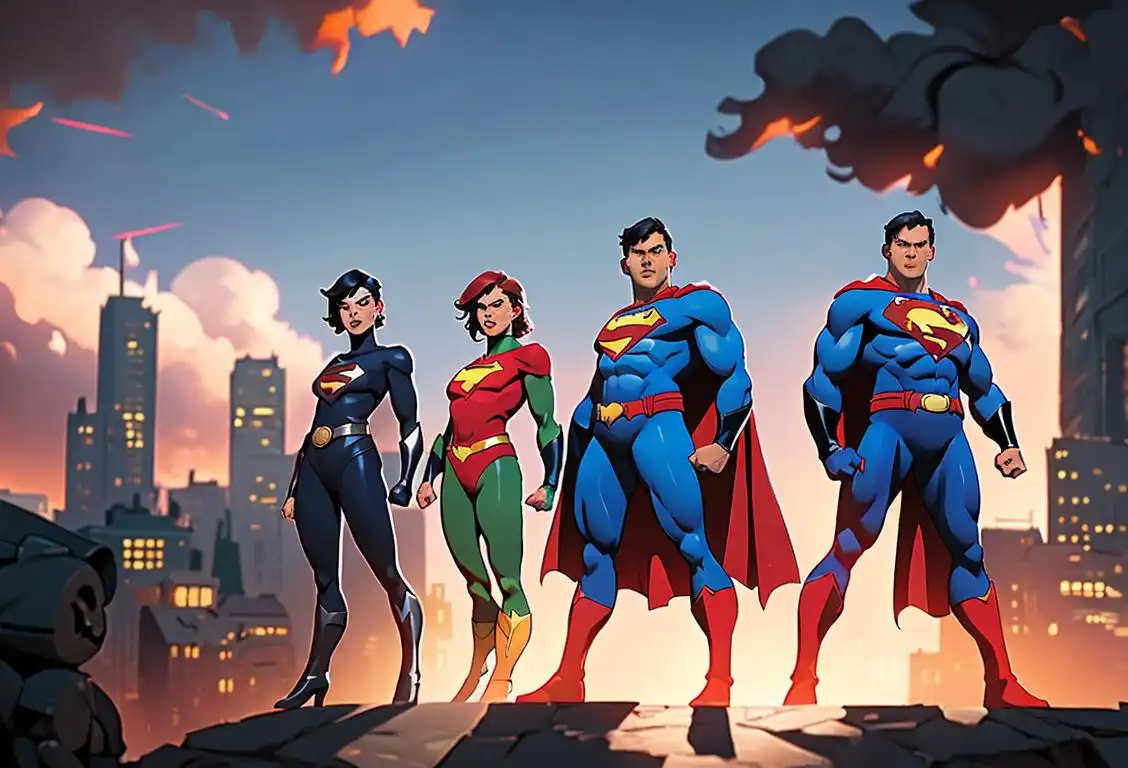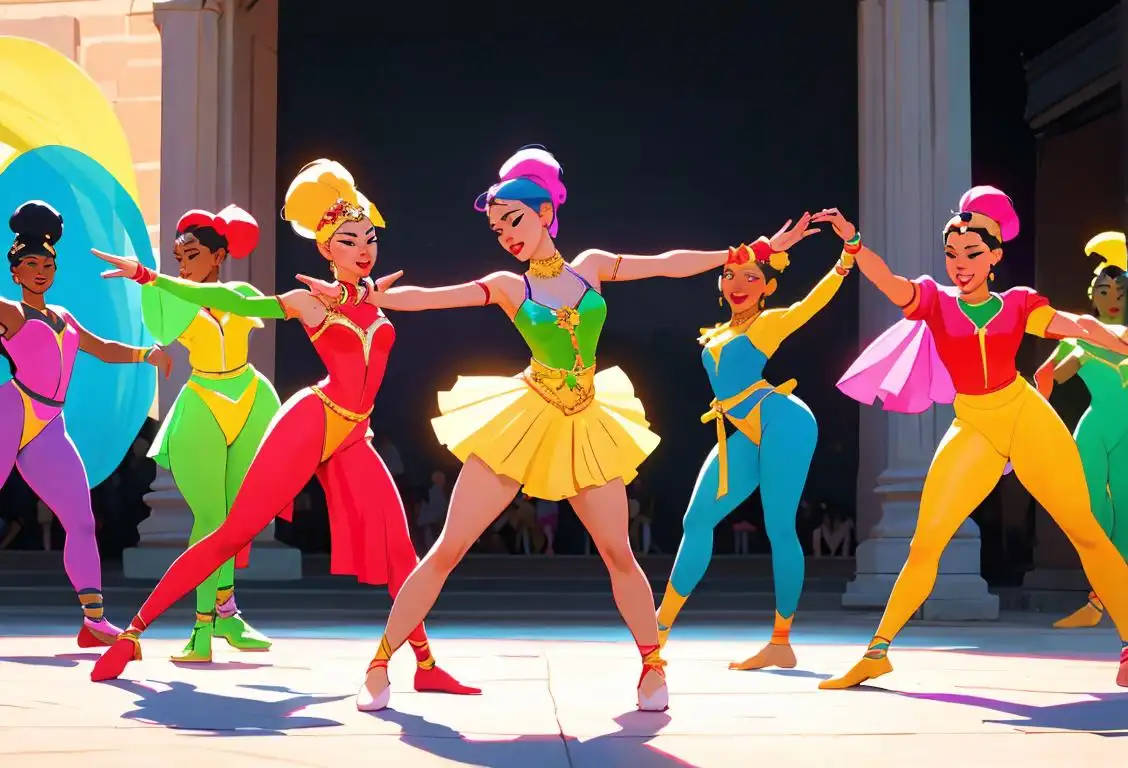National Big Butt Day

Welcome to the cheekiest celebration of the year! Get ready to shake what your mama gave you because it's National Big Butt Day! This day is all about embracing those bountiful behinds and celebrating the beauty of curves. So, grab your favorite pair of jeans and let's dive into the wondrous world of big butts!
When is Big Butt Day?
It's national big butt day on the 19th October.
The Internet History of National Big Butt Day
Just like any other national day, National Big Butt Day originates from the depths of the internet. It's unclear exactly when this glorious day came into existence, but its popularity has been growing exponentially in recent years.
Big butts have gained quite the following, thanks to celebrities like Jennifer Lopez, Kim Kardashian, and Sir Mix-a-Lot, who famously proclaimed, 'I like big butts and I cannot lie.' Their influence on pop culture and the rise of body positivity movements have contributed to the celebration of big booties everywhere.
Social media plays a significant role in the recognition of National Big Butt Day. Hashtags like #NationalBigButtDay and #Bootyful are flooded with cheeky photos and empowering messages. People proudly show off their derrieres and share tips on how to keep those glutes in shape.
Fun Ways to Celebrate National Big Butt Day
Now that you know the background, here are some fun ways to celebrate National Big Butt Day:
- Throw a Bootylicious Party: Gather your friends, put on some Beyoncé, and shake what your mama gave you on the dance floor.
- Try a Booty-Busting Workout: Check out fitness classes that focus on toning and strengthening your glutes. Squats, lunges, and hip thrusts will be your new best friends.
- Dress to Impress: Embrace your curves and wear clothes that accentuate your big butt. Rock those bodycon dresses, high-waisted jeans, or curve-hugging leggings with confidence.
- Spread Body Positivity: Use this day as an opportunity to spread love and acceptance for all body types. Let's celebrate the beauty of diversity and empower everyone to love themselves – big butt or not!
Did You Know?
The human buttocks are made up of a combination of muscles, fat, and connective tissue. The gluteus maximus, medius, and minimus are the primary muscles responsible for giving your posterior that fabulous shape.
History behind the term 'Big Butt'
1700s
Early References
In the early 1700s, there were references to the term 'big butt' emerging. The phrase was used to describe individuals who had a larger or more rounded buttocks. It became a way to highlight or emphasize this physical feature, and it started to gain traction in cultural discussions and popular writings.
16th century
The Rise of the Portly Physique
During the 16th century, there was a significant shift in beauty standards. Full-figured women were revered for their abundant curves, including round buttocks. In many cultures around the world, having a larger buttock was seen as a symbol of fertility and attractiveness. This admiration for big butts played a prominent role in art, literature, and even fashion.
1920
Jazz era and the rise of the Flapper
In the 1920s, a cultural shift known as the Jazz Age took place in the United States, characterized by the popularity of jazz music, speakeasies, and the emergence of flappers. Flappers were young women who challenged social norms and embraced a more liberated lifestyle. They were often associated with dancing and socializing in clubs, where the music and dancing encouraged freedom of movement and self-expression.
1804
The Emergence of the Term
The term 'big butt' first emerged in the English language around 1804. The word 'butt' was already a slang term used to describe the buttocks, and the addition of 'big' emphasized the size and prominence of this particular body part. The term started to gain popularity in informal conversations, eventually finding its way into various cultural expressions.
1700s
The Emergence of the Term
In the 1700s, the term 'big butt' started to emerge in English vernacular. It referred to an individual with a substantial and prominent posterior. At the time, having a well-rounded derrière was often associated with attractiveness and fertility.
1700s
The rise of the curvaceous figure
In the 1700s, during the Rococo period, there was a shift in beauty standards where a curvaceous figure with a plump derriere became highly desirable. This preference for a fuller behind helped spark the early notion of the term 'big butt'. Artists and sculptors during this time often depicted women with voluptuous figures, portraying them as symbols of fertility and wealth.
1800s
The Evolution of Body Ideals
In the 1800s, body ideals were focused on a slim and slender figure. The term 'big butt' was not commonly used or admired during this time, as it was contrary to the prevailing beauty standards.
1977
Emergence of the term 'big butt'
In 1977, the term 'big butt' emerged as a slang term that refers to a larger than average buttocks. It commonly conveys an appreciation for a curvier figure, celebrating body diversity and challenging beauty standards. The term gained popularity in various communities and became a cultural phenomenon.
17th century
Early references to curvaceous figures
During the 17th century, there were already references in literature to curvaceous figures and the appreciation for fuller body types. Artists like Peter Paul Rubens prominently featured voluptuous women in their paintings, celebrating the beauty of a shapely behind.
1800s
Early references in literature
The term 'big butt' can be traced back to the 1800s when it began to appear in various forms of literature. Writers and poets often used the term to describe a woman with a curvaceous posterior. This initial mention helped to popularize the term and its association with a voluptuous figure.
1920s
The Jazz Age and a shift in beauty standards
In the 1920s, the Jazz Age brought about a shift in beauty standards. The era embraced a more liberated and carefree attitude towards life and fashion. This shift also led to a change in the perception of body ideals, with a focus on the 'flapper' style and a desire for a more slender figure.
1992
Music's influence on popularizing 'big butt'
1992 is often regarded as a pivotal year for the popularization of the term 'big butt.' The success of Sir Mix-a-Lot's iconic song, 'Baby Got Back,' contributed to the mainstream acceptance and acknowledgment of the beauty of a fuller posterior. With its catchy lyrics and empowering message, the song broke barriers and sparked conversations about body positivity.
1920s
The evolution of dance styles
During the 1920s, dance styles like the Charleston and the Lindy Hop gained popularity. These dances involved energetic movements that accentuated the hips and buttocks. This era saw a surge in the appreciation for a well-defined behind, giving further prominence to the term 'big butt'. The dances allowed individuals to revel in their natural body movements, breaking away from the strict social norms of earlier decades.
1920s
Influence of Jazz Age
During the 1920s, known as the Jazz Age, popular culture began to embrace new forms of entertainment, such as jazz music and dancing. The emphasis on rhythm and movement brought attention to the body, particularly the hips and buttocks. This cultural shift further contributed to the term 'big butt' becoming more widely recognized and celebrated.
1930
Appearing in Jazz Music
In the 1930s, 'big butt' made its way into African-American jazz music. Musicians and singers began incorporating the term into their lyrics, celebrating the beauty and allure of women with curvier figures. Jazz music played a significant role in spreading the term beyond informal conversations and into popular culture.
1940
Swing music and the love for rhythm
During the 1940s, swing music became highly popular, and people flocked to dance halls to enjoy lively and energetic dances like the Lindy Hop and Jitterbug. These dances emphasized movement of the hips and legs, showcasing athleticism and rhythm. As these dances gained popularity, the focus on lower body movement brought attention to the curves and shape of the buttocks. The love for rhythm and dancing further contributed to the cultural significance of the posterior.
18th century
The Influence of the Rococo Era
In the 18th century, the Rococo era emerged, characterized by its focus on opulence, romanticism, and decorative arts. This period celebrated all things luxurious, including voluptuous figures. Paintings from this time frequently depicted women with prominently round derrieres, further popularizing the idea of the 'big butt'. The Rococo movement had a significant impact on beauty ideals and continued to shape the perception of attractiveness.
1800s
The Rise of Body Positivity
During the 1800s, the concept of body positivity began to gain traction. This movement challenged traditional beauty standards and celebrated diversity in body shapes and sizes. The term 'big butt' became less stigmatized and more embraced as a symbol of beauty and allure.
1800s
Cultural Perceptions
During the 1800s, the perception of 'big butt' began to undergo a shift. In some cultures, a larger posterior became a sign of attractiveness and fertility. This perception can be seen in different artistic representations of the time, where curvier figures were celebrated. The term started gaining more nuanced connotations and became intertwined with notions of sensuality and beauty.
1920s
The Emergence of the Flapper Culture
In the 1920s, the flapper culture emerged, challenging traditional notions of femininity. These young women embraced a more liberated and carefree lifestyle. The ideal body shape shifted towards a more boyish figure with a flattened bust and a straighter waistline. During this time, a 'big butt' was still not regarded as fashionable.
1995
Media embracing 'big butt'
By 1995, the media started to embrace the concept of a 'big butt' as a desirable physical attribute. Influential figures like Jennifer Lopez, who had a curvier figure, emerged as prominent icons, challenging conventional beauty standards. Lopez's confidence and talent helped shape a new perspective on body image, inspiring many women to embrace their natural shapes.
1992
Hip-hop, body positivity, and mainstream recognition
In the early 1990s, hip-hop music and culture began to influence mainstream society. Hip-hop artists like Sir Mix-a-Lot gained huge popularity with songs like 'Baby Got Back' that celebrated women with curvier figures, including those with 'big butts.' These songs promoted body positivity and rejected the traditional beauty standards that favored thinness. The mainstream recognition of big butts as an attractive and desirable feature can be attributed to the influence of hip-hop culture.
1960s-1970s
Rise of African-American influence
In the 1960s and 1970s, there was a significant rise in African-American influence on popular culture, including music, fashion, and dance. This period saw the emergence of styles like funk, soul, and disco, which celebrated the beauty of fuller figures, including bigger buttocks. As these cultural movements gained momentum, so did the recognition and acceptance of the term 'big butt' as a positive descriptor.
Late 20th century
The Evolution in Popular Culture
Throughout the late 20th century and into the 21st century, popular culture significantly influenced the perception and desirability of a 'big butt'. Icons like Jennifer Lopez and Beyoncé rose to prominence, celebrated for their shapely figures. The emergence of hip-hop and its emphasis on curves further propelled the popularity of big butts in mainstream media. This cultural shift challenged traditional beauty standards and encouraged body positivity and diversity.
1990s
The rise of hip-hop culture
In the 1990s, hip-hop music and culture captured the mainstream, influencing fashion, music, and language. The term 'big butt' became more prevalent in lyrical content celebrating and praising women with curvier figures. Artists like Sir Mix-A-Lot's iconic song 'Baby Got Back' (1992) played a significant role in popularizing the term and promoting body positivity among women with fuller behinds.
1960s
The rise of the 'hourglass curve' trend
By the 1960s, the concept of the 'hourglass curve' became a prominent beauty trend. Celebrities like Marilyn Monroe and Sophia Loren were celebrated for their curvaceous figures, which included a prominent derriere. This decade marked a resurgence in the appreciation for fuller body types.
1960s
The Rise of the Curvaceous Figure
By the 1960s, cultural attitudes towards beauty began to change. Iconic figures like Marilyn Monroe and Brigitte Bardot popularized the curvaceous figure, which included a more prominent derrière. This shift in body ideals highlighted the allure and desirability of a shapely 'big butt', allowing it to become more accepted and appreciated.
1900s
The Influence of Popular Culture
In the 1900s, popular culture played a significant role in shaping attitudes towards body image. Music genres like jazz, reggae, and hip-hop showcased performers with prominent derrières, further popularizing the term 'big butt.' Artists like Josephine Baker, Queen Latifah, and Sir Mix-a-Lot celebrated curves and brought attention to the beauty and power of a big butt.
1960s
Expansion in Popularity
During the 1960s, 'big butt' started to gain more popularity in popular culture. With the rise of various music genres like funk and soul, which celebrated rhythmic movement and emphasized the posterior, the term began to frequently appear in song lyrics and dance moves. This helped to normalize and integrate 'big butt' as a mainstream concept.
1970
The Rise of Pop Culture References
By the 1970s, the term 'big butt' started to gain traction in mainstream pop culture. In this era, comedy routines, music, and movies began referencing and appreciating the aesthetic appeal of larger buttocks. These cultural references further solidified the term's place in popular usage and contributed to creating a positive and body-positive image surrounding this physical feature.
1990s
Hip-hop culture and the rise of 'bootylicious'
In the 1990s, hip-hop culture influenced the mainstream perception of beauty. The term 'bootylicious' gained popularity through songs like Destiny's Child's hit single, celebrating curves. The increased focus on buttocks led to a popularization of the term 'big butt,' epitomizing a desirable body feature.
2000s
Internet culture and memeification
With the rise of internet culture in the 2000s, the term 'big butt' took on a life of its own. Memes, viral videos, and social media platforms further propelled the popularity of celebrating larger derrieres. Numerous hashtags, such as #bootygoals or #thickthighssavelives, emerged, encouraging body confidence and acceptance.
1980s
The Era of Pop Culture and Popularity
The 1980s marked the rise of pop culture and a new wave of influential figures. Celebrities like Jennifer Lopez and Beyoncé became known for their hourglass figures, including well-defined buttocks. This led to a surge in the popularity and admiration of 'big butts', with the term gaining mainstream recognition and positive connotations.
2000s
Pop culture and media's impact
With the advent of the 2000s, pop culture and media played a pivotal role in further popularizing the term 'big butt.' Celebrities like Jennifer Lopez, Kim Kardashian, and Beyoncé embraced their curvier figures and became global icons. Their prominence within the entertainment industry helped reshape beauty standards and challenged the notion that attractiveness solely depends on a slim physique. As a result, 'big butt' became a widely recognized term and was no longer considered taboo but celebrated and desired.
1990s
Mainstream Acceptance
In the 1990s, 'big butt' reached a new level of mainstream acceptance. With the influence of pop culture icons like Jennifer Lopez and Sir Mix-a-Lot's hit song 'Baby Got Back,' the concept of a big butt became widely embraced. Body positivity and appreciation for diverse body types became a predominant theme, further solidifying the term in popular culture.
Current Day
The Rise of Body Positivity
In recent years, the body positivity movement has gained traction, celebrating bodies of all shapes and sizes. This inclusive movement promotes self-acceptance and challenges unrealistic beauty standards. A growing emphasis on embracing diverse body types has contributed to a more positive perception of big butts. Rather than being viewed as a physical flaw, having a larger posterior is increasingly celebrated as a unique and beautiful feature.
2000s
The body positivity movement
As societal beauty standards evolved, the 2000s witnessed a surge in the body positivity movement. This movement aimed to challenge narrow definitions of beauty and embrace diverse body types. The term 'big butt' took on a positive connotation, with people embracing and celebrating their natural curves. Social media platforms played a vital role in providing a platform for body positivity and promoting acceptance of different body shapes and sizes.
1990s
Mainstream popularization and controversy
In the 1990s, the term 'big butt' experienced a surge in mainstream popularity. Influential figures like Sir Mix-a-Lot's hit song 'Baby Got Back' emphasized body positivity and the attractiveness of a larger derrière. However, this also led to controversies surrounding objectification and stereotypes. The term became a point of discussion, both in terms of cultural acceptance and the portrayal of women in media.
1992
Sir Mix-a-Lot's 'Baby Got Back'
One of the most iconic moments in the popularization of the term 'big butt' occurred in 1992 with the release of Sir Mix-a-Lot's hit song, 'Baby Got Back.' The song's catchy lyrics celebrate and embrace curvaceous bodies, placing a special emphasis on big buttocks. The immense success of 'Baby Got Back' helped propel the term into the mainstream and solidify its cultural significance.
2000s
Mainstream Acceptance and Celebrations
By the 2000s, a big butt had become widely accepted as an attractive feature in mainstream culture. Celebrities like Jennifer Lopez, Beyoncé, and Kim Kardashian gained immense popularity and became known for their curvaceous figures. The term 'big butt' transcended racial and cultural boundaries, symbolizing confidence, sensuality, and empowerment.
Present day
Body positivity and embracing diverse beauty
Presently, there is a growing movement towards body positivity and a celebration of diverse beauty standards. The term 'big butt' has become more accepted and is often celebrated as a symbol of confidence and femininity. It represents the appreciation for differing body types and the rejection of narrow beauty ideals.
Present Day
Continued cultural impact and body positivity
In the present day, the term 'big butt' continues to have a cultural impact, promoting body positivity and inclusivity. Influencers, celebrities, and artists embrace and celebrate different body types, helping reshape societal beauty standards. The term serves as a means to empower individuals and challenge the narrow definition of attractiveness.
Present
Cultural Empowerment
Today, the term 'big butt' continues to be a part of cultural discourse and body positivity movements. It is seen as an attribute that can promote self-confidence and acceptance. The term has transcended social boundaries and is celebrated across various cultures and communities, highlighting the ever-evolving nature of beauty standards and the recognition of the diverse beauty in all body types.
21st century
Shift towards body positivity
In the 21st century, there has been a significant shift towards body positivity and embracing diverse body types. The term 'big butt' is no longer exclusively associated with objectification but has become a symbol of confidence and self-acceptance. This cultural evolution encourages the celebration of diverse body shapes and challenges societal beauty standards.
2014
The Big Butt Trend
In the 2010s, a new cultural phenomenon emerged, known as the 'big butt trend.' Influenced by celebrities like Kim Kardashian and Jennifer Lopez, a growing number of people started desiring and pursuing fuller buttocks. This trend not only popularized the term 'big butt' further but also sparked conversations about body diversity and body acceptance.
Present Day
The Cultural Impact
In the present day, the term 'big butt' has become widely used in both popular culture and everyday language. It is now recognized as a desirable physical attribute, exemplifying beauty, confidence, and sensuality. This cultural shift in body ideals acknowledges a more diverse and inclusive definition of attractiveness.
Did you know?
Did you know that having a bigger butt can actually have some health benefits? Studies have shown that a larger derriere may help reduce the risk of certain medical conditions, such as heart disease and diabetes. So, not only is it aesthetically pleasing, but it might also contribute to your overall well-being!Tagged
awareness funFirst identified
11th October 2017Most mentioned on
19th October 2020Total mentions
12Other days
Nurses Day
Former Prisoner Of War Recognition Day
Press Day
Handloom Day
Heroes Day
Memorial Day
Dance Day
Bestfriends Day
Liberation Day
Love Your Pet Day









